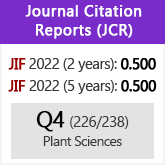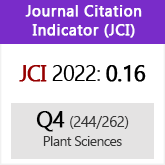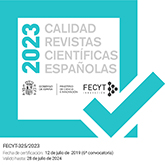The involvement of Narcissus hispanicus Gouan in the origin of Narcissus bujei and of cultivated trumpet daffodils (Amaryllidaceae)
DOI:
https://doi.org/10.3989/ajbm.2219Keywords:
Narcissus hispanicus, daffodil origin, origin of N. bujeiAbstract
To investigate the origin of cultivated trumpet daffodils the genome size (2C-value) of more than 100 old and new cultivars were measured. A large number of concolored yellow tetraploid cultivars with large coronas seem to be derived from a doubling of chromosomes of a hybrid of the two species N. hispanicus Gouan and N. pseudonarcissus L. This can also still be recognized by the presence of a black spot at the top of the anthers in about 15 % of the tetraploid cultivars. Assuming N. pseudonarcissus as one of the parents of the allotetraploid cultivars, species of trumpet daffodils of section Pseudonarcissi investigated earlier were compared. Doubling of the nuclear DNA content of 23.8 pg of N. pseudonarcissus falls short of the values found for the trumpet daffodils. Species of trumpet daffodils of section Pseudonarcissi with a complementing higher amount of nuclear DNA like N. hispanicus with 25.8 pg, N. poeticus L. with 26 pg and the hexaploid N. pseudonarcissus ssp. bicolor (L.) Baker with 67.7 pg (Zonneveld,2008) and other species were evaluated. N. hispanicus with 25.8 pg clearly differs from N. pseudonarcissus with 23.8 pg and is accepted here also as a species. The nuclear DNA content of N. bujei (Fern. Casas) Fern. Casas with 30 pg fits with the (ancient) hybrid origin for N. bujei between N. longispathus Pugsley (36 pg) and N. hispanicus Gouan (25.8 pg). The tetraploids with white tepals and yellow corona’s can be obtained by crossing a diploid N. pseudonarcissus with the hexaploid and bicolored N. pseudonarcissus ssp. bicolor (L.) Baker.
Downloads
References
Baker, J.G. 1888. Handbook of the Amaryllideae, including the Alstroemerieae and Agaveae. Bell & Sons, London.
Blanchard, J. 1990. Narcissus, a guide to wild daffodils. Published by Alpine Garden Society, Lye End Link, Woking, UK.
Blanchard, J. 1998. Narcissus update. Bulletin of the Alpine Garden Society, Great Britain: 330-337.
Brandham, P.E. & Kirton, P.R. 1985. The chromosomes of species, hybrids and cultivars of Narcissus L. (Amaryllidaceae). Kew Bulletin 65-102.
Codina, C. 2002. The production of galanthamine by Narcissus tissues in vitro in: Narcissus and daffodils: The genus Narcissus. Ed. Hanks G.R. Taylor & Francis LTD, UK.
Curtis, W. 1788. Narcissus major. Great daffodil. Botanical Magazine: t. 51.
Fernandes, A. 1968a. Contribution a la connaisance de la biosystematique de quelques especes du genre Narcissus L. Portugaliae Acta Biologica 9: 1-44.
Fernandes, A. 1968b. Keys to the identification of native and naturalized taxa of the genus Narcissus L. R.H.S Daffodil and Tulip Yearbook: 37-66.
Fernandes, A. & Almeida, M.T. 1971. Sur les nombres chromosomique de quelques formes horticoles du genre Narcissus L. Boletim Sociedade Broteriana 45: 227-244.
Fernandes, A. & Franca, F. 1974. Sur le comportement des heterochromatinosomes chez une population de Narcissus hispanicus Gouan. Boletim da Sociedade Broteriana 48: 30-35.
Fernandes, A. & Fernandes, R. 1946. Sur la caryo-systematique du sous-genre Ajax Spach du genre Narcissus L. Acta Universita Coimbrigensis 1: 1-33.
Fernández Casas, J. 1986. Narcissus bugei (Fernández Casas) Fernández Casas, comb. nova. Lagascalia 14: 176.
Fernández Casas, J. 2000. Narcissus hispanicus subsp. bujei (Fern. Casas) Fern. Casas. Fontqueria 54(1-6): 126.
Gouan, A. 1773. Illustrationes et observationes botanicae: 23. Orell, Gesner, Fuesslin et Soc., Zürich (“Figuri”).
Graham, S.W. & Barrett, S.C.H. 2004. Phylogenetic reconstruction of the evolution of stylar polymorphism in Narcissus (Amaryllidaceae). American Journal Botany 91: 1007-1021. doi:10.3732/ajb.91.7.1007
Meadows, G.E.M. 1972. A host of daffodils. Bulletin Alpine Garden Society of Great Britain 40: 98-106.
Mehra, P.N. & Dachveda, S.K. 1976. Cytological observations on some west Himalayan monocots. V. Araceae. Cytologia 41: 55-61.
Mol, W.E. de. 1923. Het verdwijnen der diploide en triploide magnicoronate narcissen uit de grote cultures en het er voor in de plaats treden van tetraploide vormen. Proceedings Section Sciences Koninklijke Akademie van Wetenschappen, Amsterdam 31: 296-300.
Montserrat Martí, J.M. & Vives, P. 1991. Números cromosomáticos en Narcissi (Amaryllidaceae). Fontqueria 31: 145-148.
Nagao, S. Number and behavior of chromosomes in the genus Narcissus. Memoirs of the college of Science, Kyoto Imperial University VIII-2: 1-192.
Pugsley, H.W. 1933. A monograph of Narcissus, subgenus Ajax. Journal Royal Horticular Society 58: 17-93.
Rois-Ruiz, S., Rivera-Núñez, D., Algaraz-Ariza, F. & Obón de Castro, C. 1998. Three new species of Narcissus L. subgenus Ajax Spach (Amaryllidaceae) restricted to the meadows and forests of south-eastern Spain. Botanical Journal Linnean Society 131: 153-165. doi:10.1111/j.1095-8339.1999.tb01846.x
Sañudo, A. 1984. Estudios citogenéticos y evolutivos en poblaciones españolas del género Narcissus L. sect. Pseudonarcissi DC. Nota previa: números de cromosomas. Anales del Jardín Botánico de Madrid 40: 361-367.
Smythies, B.E. 1973. A note on Narcissus hispanicus Gouan (N. major Curtis) in the Sierra de las Nieves, Malaga. Lagascalia 3: 49-52.
Tiersch, T.R., Chandler, R.W., Wachtel, S.S.M. & Ellias S. 1989. Reference standards for flow cytometry and application in comparative studies of nuclear DNA content. Cytometry 10: 706-710. doi:10.1002/cyto.990100606 PMid:2582960
Webb, D.A. 1980. Narcissus. In: T.G. Tutin & al. (eds), Flora Europaea 5: 78-84. Cambridge University Press, Cambridge.
Williams P.D. 1929. The progress of the daffodil from 1890 to 1910, in: Daffodil growing for pleasure and profit: 233-238. Ed. A.F. Calvert London.
Wylie A.P. 1952. The history of the garden narcissi. Heredity 6: 137-156. doi:10.1038/hdy.1952.16
Zonneveld, B.J.M. 2008. The systematic value of nuclear DNA content for all species of Narcissus L. (Amaryllidaceae). Plant Systematics and Evolution 275(1,2): 109-132.
Zonneveld, B.J.M. 2009. The systematic value of nuclear DNA content for all species of Tulipa L. (Liliaceae). Plant Systematics and Evolution 281: 217-245. doi:10.1007/s00606-009-0203-7
Zonneveld, B.J.M. 2009. The systematic value of nuclear genome size for all species of Tulipa (Liliaceae). Plant Systematics and Evolution 281: 217-245. doi:10.1007/s00606-009-0203-7
Zonneveld, B.J.M. & Duncan, G.D. 2003. Taxonomic implications of genome size and pollen colour and vitality for species of Agapanthus L’Heritier (Agapanthaceae). Plant Systematics and Evolution 241: 115-123. doi:10.1007/s00606-003-0038-6
Zonneveld, B.J.M. & Duncan, G.D. 2006. Genome size for species of Nerine Herb. (Amaryllidaceae) and its evident correlation with growth cycle, leaf width and other morphological characters. Plant Systematics and Evolution 257: 251-260. doi:10.1007/s00606-005-0381-x
Zonneveld, B.J.M. & Van Iren, F. 2001. Genome size and pollen viability as taxonomic criteria: Application to the genus Hosta. Plant Biology 3: 176-185. doi:10.1055/s-2001-12900
Zonneveld, B.J.M., Grimshaw, J.M. & Davis, A.P. 2003. The systematic value of nuclear DNA content in Galanthus. Plant Systematics and Evolution 241: 89-102. doi:10.1007/s00606-003-0016-z
Downloads
Published
How to Cite
Issue
Section
License
Copyright (c) 2010 Consejo Superior de Investigaciones Científicas (CSIC)

This work is licensed under a Creative Commons Attribution 4.0 International License.
© CSIC. Manuscripts published in both the printed and online versions of this Journal are the property of Consejo Superior de Investigaciones Científicas, and quoting this source is a requirement for any partial or full reproduction.All contents of this electronic edition, except where otherwise noted, are distributed under a “Creative Commons Attribution 4.0 International” (CC BY 4.0) License. You may read here the basic information and the legal text of the license. The indication of the CC BY 4.0 License must be expressly stated in this way when necessary.
Self-archiving in repositories, personal webpages or similar, of any version other than the published by the Editor, is not allowed.

















